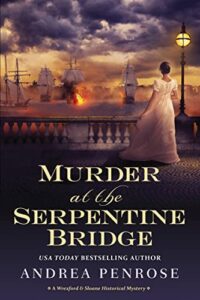The Regency era is often viewed by present-day readers as a romantic time of fancy silks and satins, filled with glittering balls in Mayfair mansions and country house parties at grand estates. But there is a grittier side to the era. Historians consider it to be the birth of the modern world, with radical new ideas coming to life and fomenting fundamental changes in every aspect of society.
This is especially true in science and technology, as innovations in chemistry, medicine and engineering—to name just a few of the disciplines—were turning the old world upside down. In my Wrexford & Sloane mystery series, I use scientific innovation as the core catalyst for each book’s mystery, and my research down various “rabbit holes” has led me to some really fascinating discoveries.
The new technology was a positive force in so many ways and changed countless lives for the better, but in digging deeper into the history firearms for my newest book, which releases this month, I was surprised to learn that a number of our most frightening modern weapons had their beginnings in the Regency!
It actually shouldn’t have come as a surprise. The Napoleonic Wars were raging for much of the Regency era, as Britain fought a titanic struggle with France to be the dominant world power. And the bloody conflict proved to be a catalyst for deadly new weaponry. Here are just a few examples . . .
Inspired by the gunpower rockets used by the Indian sultanates against the East India Company during the Anglo-Mysore Wars, Sir William Congreve first invented a military rocket for the British in 1804. Working in the research laboratories of the Royal Arsenal at Woolwich, he soon had his missiles capable of traveling over 3,000 yards. Made of iron and ranging in size from massive 300 pounders to light field rockets that could easily be moved around the battlefields, the Congreve rocket proved an effective weapon, especially for long range bombardment of fortifications where precise accuracy wasn’t crucial. (However, the Duke of Wellington hated them because they scared the cavalry horses!)
Congreve rockets also become a popular weapon for the Royal Navy and were used in the War of 1812 to bombard Fort McHenry in Baltimore—thus “the rocket’s red glare” in the American national anthem! These days, we have sophisticated intercontinental ballistic missiles, but rocket technology really got off the ground during the Regency.
Another explosive invention was created by Henry Shrapnel. In 1804, using Shrapnel’s concept of a “spherical shell” filled with metal fragments, the British military began using a type of projectile that threw off a rain of deadly fragments when it burst, thus paving the ways for the modern cluster munitions.
An American comes into play when talking about submarine warfare. The inventor Robert Fulton, who launched the first-ever commercial steamboat, also developed Nautilus, a design for a submarine which he tried to sell to Napoleon to use against the British Royal Navy. In a trial run, he and a small crew descended to a depth of 25 feet and stayed submerged for an hour. However, when Napoleon asked for a demonstration, Fulton was in the middle of reworking the prototype because of leaks, and Napoleon decided the American was a charlatan. (He was know to dislike sea warfare in general.)
The British quickly expressed interest in the submarine and Fulton headed to London. But the Battle of Trafalgar gave Britain command of the seas, so they decided they didn’t need the new technology and let the project sink into oblivion. Today, of course, submarines are an integral part of any military arsenal, put in motion by Fulton’s creative imagination.
Moving to rifles, I’ll take a slight step back into the Georgian era to talk about the precursor to assault rifles like the AK-74. Muskets—which fired one shot and then had to be reloaded in a process that required several steps—were the standard military firearm of the era. However, I discovered that during the American Revolution, the British army had an experimental rifle brigade armed with the Ferguson rifle, a breech-loading weapon invented by Colonel Patrick Ferguson, who received a patent for it in 1776. The rifle could fire 6-8 shots per minute, compared with a musket, which required a skilled soldier to fire 3-4 shots per minute. That was quite an advantage in firepower!
However, the Ferguson rifles tended break down in the heat of battle. And as all the parts were handmade (technology had not yet advanced to being able to mass produce identical parts) it took too long to repair them, so the project was put on hold.
The rapid-fire multi-shot pistol was also a Regency-era innovation. Invented by Elisha Collier, an American living in London, the Collier pistol ( upon which I have based my current mystery) was patented in 1818, and is said to have inspired Samuel Colt to create his famous “six-shooter.” It was a flintlock revolver, and became popular with officers posted to India. The cylinder had to be manually rotated, but still it was, in effect, the basic inspiration for James Bond’s famous Walther PPK.
And then there was Humphry Davy, the brilliant chemist and head of the Royal Institution, Britain’s leading scientific organization. A charismatic lecturer, Davy was the darling of London Society and aristocratic gentlemen and ladies flocked to hear his scientific lectures. In addition to inventing the safety lamp, which saved the lives of countless miners, Davy also was involved in a mysterious laboratory accident that injured one of his eyes in 1811. There is credible evidence that he was working on a secret project for the British military that involved concocting a powerful chemical explosive.
He apparently backed off from the project, and it took until later in the century for other chemist named Alfred Nobel to invent dynamite and gelignite. But it seems likely that Davy deserves credit for the first experiments in chemical explosives for use in warfare.
***





















